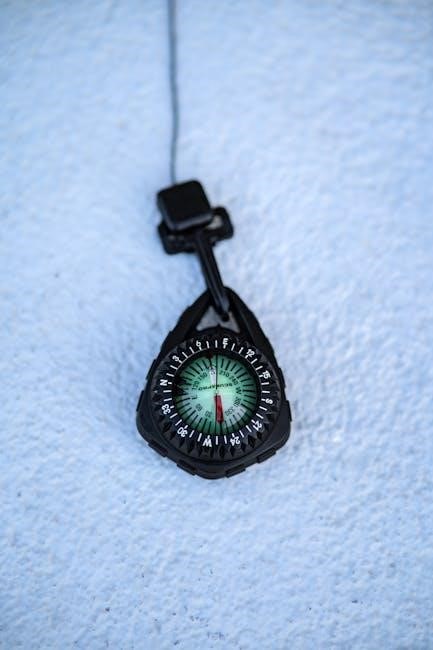Overview of the Pathfinder Cleric Class
Pathfinder Clerics are divine spellcasters who serve higher powers, offering healing, support, and combat prowess. They rely on Wisdom for magic, making them versatile in both battle and party assistance.
1.1 Role of the Cleric in a Party
Clerics serve as versatile supporters, combining healing, divine magic, and combat skills. They are essential for sustaining allies, offering tactical advantages, and adapting to various challenges. Their ability to heal and provide buffs makes them indispensable, while their combat prowess ensures they can hold their own in battle, making them a cornerstone of any party’s success and flexibility.
1.2 Key Abilities and Attributes
Clerics rely heavily on Wisdom, which fuels their divine magic and spellcasting abilities. Constitution enhances endurance, granting higher hit points for frontline roles. Strength or Dexterity supports melee combat, while Charisma aids in social interactions and Divine spell effects. Balancing these attributes ensures versatility, allowing Clerics to excel in both support and combat scenarios effectively.
1.3 Divine Magic and Spellcasting
Clerics derive their magic from their deity, using Wisdom to cast divine spells. They prepare spells daily, with their spell slots determined by class level. Clerics can heal, protect, or smite foes, with access to a wide range of spells. Their divine connection grants unique abilities, such as channeling energy or domain powers, making them versatile spellcasters in both combat and exploration.
Choosing a Deity and Domains
Selecting a deity aligns the cleric with their principles, granting domain powers that shape their abilities. Domains offer unique spells and powers, defining the cleric’s role and combat style.
2.1 Importance of Deity Selection
Selecting a deity defines the cleric’s purpose and abilities, as their powers are derived from their chosen god. This choice determines their domain access, spellcasting focus, and alignment, shaping their role in both combat and storytelling. A deity’s edicts also influence the cleric’s behavior, making this decision central to their identity and gameplay impact.
2.2 Popular Cleric Domains and Their Benefits
Popular cleric domains like Fire, Sun, and Trickery offer unique abilities enhancing versatility. Fire domain grants flame-based spells, while Sun provides radiant healing. Trickery domain boosts stealth and illusion magic. Each domain aligns with a deity’s theme, offering distinct playstyles and strategic advantages in both combat and exploration, making clerics adaptable to various party needs.

Ability Score Optimization
Optimizing a cleric’s abilities focuses on Wisdom for spellcasting, with Strength or Dexterity for combat and Constitution for survivability, ensuring a balanced divine warrior.
3.1 Prioritizing Wisdom for Spellcasting
Wisdom is the cleric’s primary ability, determining spellcasting effectiveness. A high Wisdom score enhances spell attack rolls, spell DCs, and access to higher-level divine magic. Ensuring a strong Wisdom foundation is crucial for reliable healing, damage, and utility spellcasting, making it the top priority during character creation and level progression.
3.2 Secondary Abilities for Combat and Utility
Secondary abilities like Strength, Dexterity, and Constitution enhance the cleric’s combat and utility roles. Strength improves melee effectiveness, while Dexterity boosts AC and reflex saves. Constitution increases stamina, crucial for frontline roles. Charisma aids in social interactions, complementing the cleric’s supportive nature. Balancing these abilities ensures versatility, making the cleric effective in both combat and out-of-combat scenarios.

Cleric Spells and Divine Magic
Clerics wield divine magic to heal, protect, and smite enemies, serving as pillars of support and divine intervention in any adventuring party.
4.1 Essential Cleric Spells for Different Levels
Clerics gain access to essential spells at each level, starting with Cure Wounds and Bless as fundamental cantrips. Lower-level spells like Healing Word and Shield of Faith provide early utility, while mid-level spells such as Heal and Hold Person offer strong crowd control and healing. Higher-level spells like Resurrection and Holy Smite become game-changers, ensuring Clerics remain versatile and powerful at every stage.
4.2 Preparing and Casting Spells Effectively
Effectively managing spell slots and domain powers is crucial for Clerics. Prioritize spells that align with your deity’s domain and party needs. Prepare a mix of healing, support, and combat spells, using higher-level slots for critical situations. Optimize divine interventions by timing spellcasting to maximize impact, ensuring resource efficiency and minimizing wasted potential in both combat and exploration scenarios.
Cleric Archetypes and Character Customization
Clerics can embrace various archetypes, tailoring their abilities to specific playstyles. Combined with domain choices, these options allow for deep customization, making Clerics highly adaptable to any campaign.
5.1 Popular Archetypes for Clerics
Popular Cleric archetypes include the Undead Lord, focusing on negative energy, and the Herald, emphasizing divine messaging. These archetypes allow Clerics to specialize in healing, damage, or utility, offering deep customization. Each archetype enhances specific class features, enabling Clerics to serve as frontliners, support casters, or versatile party assets, tailored to their chosen deity and playstyle.
5.2 Feats and Trait Selection for Clerics
Clerics benefit from feats like Warrior Priest for martial prowess or Channel Smite to combine attacks with divine energy. Traits such as Indomitable Will enhance resolve, while Magic Trickster boosts spell versatility. Selecting feats and traits that align with your deity and playstyle allows Clerics to excel in combat, healing, or utility roles, ensuring a balanced and customized character build.

The Cleric’s Role in Combat and Exploration
Clerics excel as versatile supporters and combatants, using divine magic to heal allies, debuff enemies, and adapt to evolving battlefield conditions while aiding in exploration and strategy.
6.1 Frontline Combat and Tanking
Clerics are formidable frontline combatants, using divine magic to bolster allies and protect themselves. With access to armor and shields, they can tank damage effectively while casting spells to heal or support the party. Their martial prowess, combined with divine intervention, makes them versatile defenders capable of holding the line and ensuring the party’s survival in intense battles.
6.2 Support and Utility in and Out of Combat
Clerics excel at providing support and utility both in and out of combat. Their divine magic allows them to heal wounds, grant protective buffs, and imbue allies with confidence. Outside of battle, they can use their spells for exploration, problem-solving, or even diplomacy, making them invaluable assets to any party. Their versatility ensures they are always prepared to aid their companions in every possible situation.
Advanced Cleric Strategies and Builds
Advanced Cleric builds focus on optimizing spellcasting, domain powers, and combat efficiency. Strategies include selecting archetypes like the Warpriest for martial prowess or the Divine Guide for enhanced support, ensuring maximum versatility in any scenario.
7.1 Optimizing for Healing and Support
Optimizing a Cleric for healing and support involves selecting domains like Life or Restoration to enhance healing efficiency. Archetypes such as the Warpriest can boost survivability, while focusing on spells like Heal and Mass Heal ensures consistent group support. Channeling divine energy strategically and preparing high-level spells for critical moments maximizes the Cleric’s role as a dependable party backbone, ensuring allies remain viable in combat.
7.2 Building a Combat-Focused Cleric
A combat-focused Cleric excels in melee, leveraging domains like War or Strength for enhanced martial prowess. Selecting spells such as Bless and Shield of Faith bolsters allies and self, while feats like Weapon Focus improve melee accuracy. Equipping heavy armor and a cleric’s vestment or amulet of mighty fists transforms the Cleric into a formidable frontline combatant or damage dealer, blending divine power with martial skill.
Cleric Character Creation Guide
Creating a Cleric involves selecting a deity, race, and background, then choosing a domain and feats. This process shapes their divine role and combat style effectively.
8.1 Step-by-Step Race and Class Selection
Selecting a race like human, half-elf, or half-orc for your Cleric provides bonuses to Wisdom, crucial for spellcasting. Choose a race that aligns with your deity’s themes; Next, pick the Cleric class, ensuring divine magic, healing, and combat readiness. This combination ensures versatility in supporting and fighting alongside your party, embodying your deity’s will effectively in the game.
8.2 Background and Equipment Choices
Choose a background like Acolyte for thematic consistency, reflecting your Cleric’s devotion. Equip chain mail or plate armor for defense, and select a shield for tanking. A holy symbol serves as your divine focus, essential for casting spells. Add healing potions and scrolls for emergencies. These choices align with your deity’s tenets, ensuring your Cleric is prepared for combat and divine service.
Level Progression and Key Features
Clerics gain improved spellcasting, domain powers, and Channel Energy at higher levels, enhancing their divine magic and versatility in both combat and support roles.
9.1 Important Class Features at Each Level
Clerics gain key features at each level, starting with Divine Magic and Channel Energy at 1st level. At 4th level, they unlock Divine Font for spellcasting flexibility. Higher levels grant improved Channel Energy, domain powers, and enhanced spellcasting abilities, culminating in 17th-level Divine Mastery, making them formidable in both combat and support roles through their divine connection.
9.2 Domain Powers and Their Progression
Clerics unlock domain powers tied to their chosen deity, starting at 1st level. These abilities enhance combat, support, or utility, with progression expanding their effects. For example, the Fire domain grants flame-based attacks that grow stronger, while the Sun domain offers healing and protection. Higher levels unlock advanced domain powers, boosting versatility and divine impact in various scenarios.
Divine Intervention and Channeling
Clerics use Channel Energy to wield divine power, healing with positive energy or harming with negative energy, with effects increasing as they gain levels.
10.1 Using Channel Energy Effectively
Clerics channel divine energy to heal or harm, with effects scaling by level. At higher levels, they can affect larger areas, making it a powerful tool for supporting allies or debilitating foes strategically.
10.2 Advanced Channeling Techniques
Advanced channeling techniques allow clerics to refine their divine energy use, maximizing impact. High-level clerics can channel energy to affect larger areas or specific targets, enhancing healing or dealing massive damage. Techniques like energy conversion and precision targeting enable clerics to adapt their channeling to situational needs, making them formidable in both combat and support roles.
Magic Items and Gear for Clerics
Clerics benefit from holy symbols, staves, and divine-themed armor. Magic items like wands of healing and cloaks of resistance enhance their survivability and spellcasting effectiveness in various scenarios.
11.1 Essential Gear for Clerics
Clerics rely on holy symbols, divine staves, and protective armor. Essential items include wands of healing, cloaks of resistance, and amulets of wisdom to boost spellcasting; Sacred weapons and shields emblazoned with religious icons enhance their martial prowess, while bags of holding and portable altars aid in preparing rituals and maintaining divine focus during adventures.
11.2 Crafting and Enchanting Magic Items
Crafting magic items requires the Craft Magic Items feat and appropriate materials. Clerics can enchant items like holy symbols, staves, or armor with divine properties. Blessing items with spells like magic weapon or armor of faith enhances their effectiveness; Crafting allows clerics to create tailored gear, such as wands of healing or cloaks of resistance, to support their divine mission.
Tips for Playing a Cleric
Mastering a cleric requires balancing healing, damage, and support. Manage spell slots wisely, prioritize party health, and adapt divine magic to suit combat needs effectively.
12.1 Managing Spell Slots and Domain Powers
Effectively managing spell slots and domain powers is crucial for clerics. Plan ahead by prioritizing essential spells for the adventure, using lower-level slots for routine tasks. Conserve higher-level slots for critical moments, and leverage domain powers to enhance your abilities without overextending. Maintain flexibility by balancing spell preparation with spontaneous casting, ensuring you can adapt to evolving combat and exploration needs while sustaining your divine magic resources.
12.2 Working with Your Party as a Support Class
Clerics excel as support characters, providing healing, buffs, and debuffs. Communicate with your party to anticipate their needs, ensuring timely interventions. Balance your role by offering both offensive and defensive support, while conserving resources for critical moments. Your versatility in divine magic allows you to adapt to any situation, making you an invaluable asset to your group’s survival and success in adventures;

Common Mistakes to Avoid
Overextending in combat and mismanaging spell slots are common pitfalls. Avoid neglecting Wisdom scores and domain powers, as they are crucial for effective spellcasting and divine interventions.
13.1 Mismanaging Spell Preparation
Mismanaging spell preparation is a critical error, as clerics must pre-select spells daily. Forgetting to prepare essential healing or combat spells can leave the party vulnerable. Overrelying on high-level spells depletes resources quickly, while underutilizing lower-level slots wastes potential. Proper planning ensures versatility, but poor choices can lead to wasted opportunities and increased risk in challenging encounters or exploration scenarios.
13.2 Overextending in Combat Situations
Overextending in combat is a common mistake for clerics, as their versatility tempts them to take on too many roles at once. Engaging multiple enemies, depleting spell slots, or neglecting defensive positioning can leave the cleric vulnerable. This overextension risks the party losing their primary healer and support, making it harder to recover from setbacks or sustain through prolonged battles effectively.

Leave a Reply
You must be logged in to post a comment.